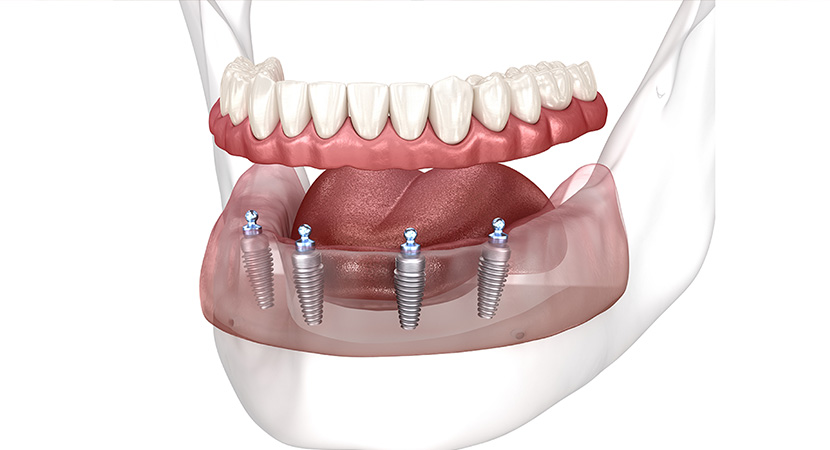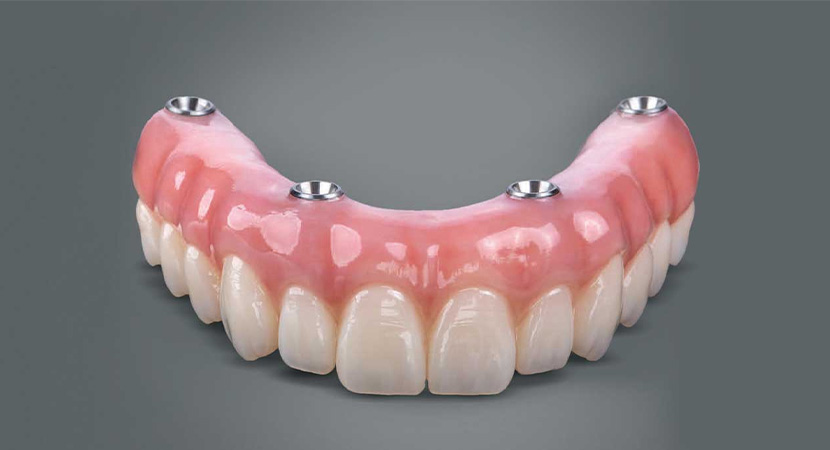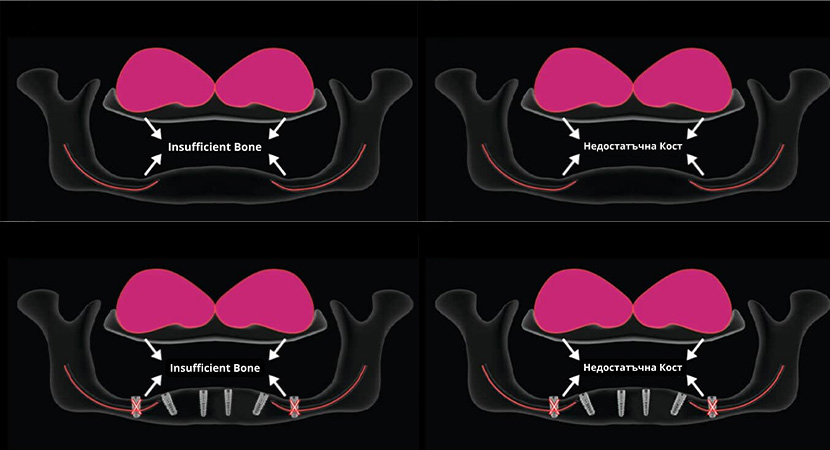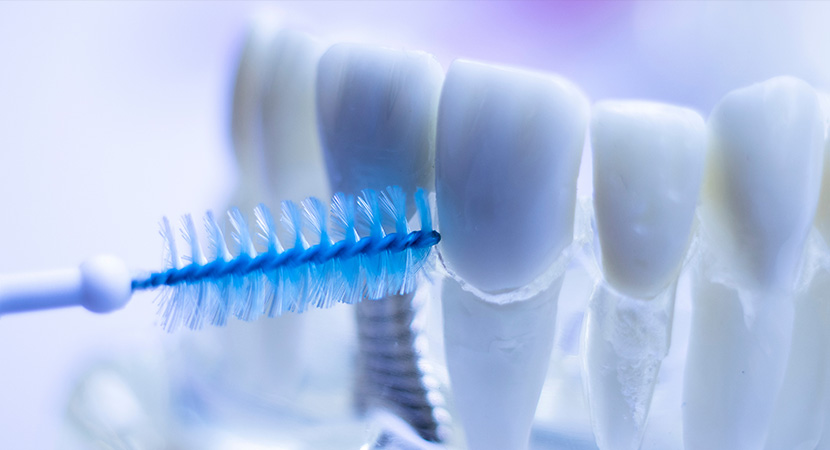
All on 4
Implantation Technique
All on 4 is an implantation technique developed by the Swedish company Nobel and Dr. Malo, a professor of Portuguese origin. It is a hybrid prosthesis ready to replace all missing teeth in the jaw after the placement of only 4 implants. The biggest advantage of the procedure is that in cases where there is not a large gap in the jawbone, the teeth can be prepared in a short period of time, for example, 1 week, without the need for additional procedures.
The loss of all teeth in the mouth is usually due to gingivitis, not caries.
The inflammation that starts in the gums spreads to the bone over time, and when the bone melts, the teeth become loose and fall out.
Treatment with All on 4 implants ensures that all teeth are fixed by screwing them onto four artificial tooth roots, instead of making an implant for each missing tooth. This provides a timely, aesthetic, and convenient chewing solution for patients who do not have enough jawbone.

How the system works
Principle of Operation of the Technique: It is based on the principle that in cases where anatomical formations such as the bottom of the sinuses and the nerve of the lower jaw are very close to the bone where the implants need to be placed, their angles are changed and placed at a distance from these formations.
In traditional approaches, ideally, implants are expected to be placed perpendicular to the forces of the jawbone and thus transmit their chewing forces to the bone. In this technique, the front two implants are placed on the bone at a 90-degree angle, while the rear implants are placed at a 45-degree angle.
Placing the remaining implants at a 45-degree angle allows for the use of longer materials as well as application in safe zones away from anatomical formations.
Since the requirements for procedures with long recovery periods, such as bone augmentation or sinus lifting, are eliminated, the recovery time is shortened, and the patient can regain their teeth in a short time.
How to implement the All on 4 concept
Your first step in treatment is consultation and examination with your dentist. During your first meeting with your dentist, you can explain how you want your final teeth to be.
Many patients bring their photos to the initial examination. These photos guide both your doctor and the laboratory as you prepare for your new teeth.
Your dentist will also want to see a panoramic X-ray or 3D tomography of the jaw to determine exactly where the implants should be placed.
Tomography support; It allows the assessment of bone density in the area where the procedure will be performed. At this stage, your dentist will explain the treatment options to you. If you decide on the procedure, a plaster model is made by measuring the lower and upper jaw, and new teeth are prepared on this model.
Dental implant treatment is usually painless. However, you can ask your dentist to apply sedation or general anesthesia.
Together with the anesthesiologist, it is assessed whether you are a suitable candidate for sedation. If you prefer sedation or general anesthesia, the anesthesia appointment should also be scheduled in advance.

All about the Prosthetic Stages
Surgical Stage
If there are broken tooth roots or teeth that need to be extracted in your mouth, these teeth are usually removed while the screws are surgically placed. This aims to reduce the number of bacteria remaining in the mouth.
Before starting the procedure, local anesthesia is applied to numb the area of the operation. The front two implants are placed perpendicular to the jawbone, while the back two are placed at an angle of 30-45 degrees to provide adequate support for restoration.
After successful implant placement, the inside of the mouth is cleaned, and the surgery is completed by placing sutures.
Placement of Teeth
After 1 week, the stitches are removed, and the prepared restoration is placed. If early loading is preferred, it is recommended to mount the teeth within the first ten days.
Some dentists prepare temporary teeth during this healing phase and cover the inner side of the palate with a soft lining to prevent damage to the wound edges. The preparation of permanent teeth may be delayed for several months after the integration of the implants.
Advantages and Disadvantages
This system offers many advantages over traditional applications.
Advantages:
• In many cases, dental implants can be placed simultaneously with tooth extraction. Not waiting for the bone healing period after tooth extraction saves the patient approximately 45 days.
• The possibility to make a tooth in 1 day and the absence of bone grafting procedures provide an advantage to the patient in the time up to 1 year in some cases.
• As it is applied at an angle towards the back, it requires a small number of screws for the entire jaw and therefore is a more economical solution.
• It provides an aesthetic appearance and smile line that can be specifically planned for the individual, enhancing smile aesthetics.
• The patient does not need to insert or remove the teeth.
So, does this system have any disadvantages? Of course, it does.
Disadvantages:
• Compared to the reliability and durability of standard implantation techniques, this is a treatment on which dentists rely relatively less compared to traditional practices.
• The finished prosthesis is not as thin and delicate as traditional implant bridges; it is slightly thicker.
• Only 4 screws provide the support needed for 14 natural teeth, and no screw is placed in the area of the molars with the greatest biting force.
• Premature loading of the teeth can cause problems leading to screw loss.
• Some patients report that air and fluid pass under these teeth, causing a whistling sound when speaking.
• Cleaning the teeth is much more difficult than with a bridge tooth. Since there are many surfaces that need to be cleaned, and the lack of adequate cleaning can cause peri-implant infection and ultimately screw loss.
• The loss of one screw leads to the unusability of the entire prosthesis.

Who is it suitable for?
The procedure as a whole is suitable for patients who do not have adequate solutions for applying traditional methods and provides exceptional stability and confidence.
Oral health practices for someone who has lost all their teeth are often a matter of debate. However, if it is not possible for you to remain toothless, even for a day due to social reasons, and you are confident that you can maintain good oral hygiene, the All on 4 technique is just for you!
In addition, fixed restoration is always recommended for patients whose jawbone and economic condition are suitable for fixed treatment. Maintenance is easier and safer.

All on 4 Care
Those who have All on 4 often experience bruising, swelling, and general discomfort in the days following the surgery. You will likely want to take a few days off to fully heal and adjust to your new teeth.
Your dentist will advise you on the foods you can and cannot eat in the months following the treatment.
During the first few months, you will likely need to eat very soft foods to prevent damage to the screws, which fuse with the bone during the healing phase. Your dentist may also recommend avoiding smoking and heavy exercise for a while.
These teeth are cleaned by brushing twice a day, just like your normal teeth. Additionally, your dentist will show you how to use special oral care tools (interdental brush, oxyjet, etc.).


